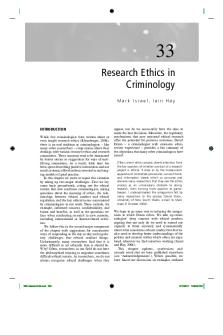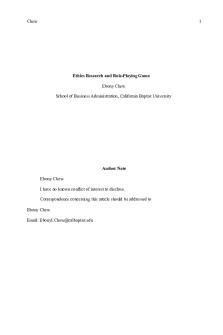Ethics in Conditioning Research PDF

| Title | Ethics in Conditioning Research |
|---|---|
| Author | carie dearing |
| Course | Research Methods In Psychology |
| Institution | University of Phoenix |
| Pages | 6 |
| File Size | 87.5 KB |
| File Type | |
| Total Downloads | 39 |
| Total Views | 158 |
Summary
essay...
Description
Running head: ETHICS IN CONDITIONING RESEARCH
Ethics in Conditioning Research PSYCH/635 February 25, 2019 Maria Cesar
1
ETHICS IN CONDITIONING RESEARCH
2
Ethics in Conditioning Research The following proposal will cover the overview of the experiment, the ethical violation that was chosen and, the alternative approach that could be used when it had to do with Pavlov’s experiments that were performed. Experiments were done on both dogs and children in order to research conditioning and to learn information about it. The way that Pavlov was able to do experiment’s back then would not be allowed at this time in our society as it would have been considered to be unethical. Overview of Experiment In the 1890’s Ivan Pavlov, became famous for his experiments regarding reflex conditioning. Pavlov, performed these experiments on both animals and humans. The finding of these experiments made him famous. The problems was that there was no regards for human life, and no one to protect the animals. The experiment that was conducted fist was on strayed dogs that were on the streets of Petersburg, in Russia. He took these dogs, operated on them and attached a device attached to their jaw this was painfully and brutal to the dogs. The device was to monitor the saliva production. Pavlov, and his workers would bring the dog food, it was hoped that certain foods would cause the dogs to salivate more. The results were unexpected the dog salivated more, but not because of the food that they were eating, but because of the people in the white coat. The dogs associated the white coats with the food, so when they saw them, the production of saliva was produced more. The saliva production had nothing to do with the foods that they were being fed. Pavlov, performed another experiment, it stilled involved dogs. This time he used electrical shock, and a pendulum. He would shock the dogs and watch them jump. The electrical shock combined with the pendulum swinging, was to see how many times it would take to shock them before they jumped. Pavlov felt that this experiment was successful, and wanted to try it on humans.
ETHICS IN CONDITIONING RESEARCH
3
He performed a similar test on humans to see how they would respond. He attached a device to the child’s wrist, the device would squeeze the child’s wrist, and feed them cookies through a tube. The child appeared to be in distress. Like the dogs the child developed a conditioning reflex. The child would automatically open its mouth when the wrist was squeezed. Pavlov was able to prove that just like dogs, humans reflexes could be conditioned also. Pavlov theory was that humans reflexes are conditioned from birth, and can be enhanced. Ethical Violation The way Ivan Pavlov used children as subjects for experiments violated ethical procedures for research. Pavlov used children to prove that in controlled reflexes people could experience their reinforcements and stimuli associated with operant conditioning. The welfare and safeguards of the children were violated through these experiments. These studies are said to have dehumanized the children as they experienced events, which should otherwise have been controlled. The right to privacy and confidentiality of personal information was broken by Pavlov who demonstrated that outside stimuli could have an influence to the actions of the child. The alternative approach that should have been taken in order to meet established ethical standards and similar goals would be to enforce punishment to any individual that misuses that ability and power. Positive punishments using rewards by parents could have been used to implement the research hence provide desired outcomes. The experiments could have been successful if they were carried out through survey setting, without infliction of any pain upon the participants of the study. The experiments that are conducted in a survey manner would remove the feeling of being forced to react to any stimuli. In addition, Ivan Pavlov should have used anonymous subjects who would be given assurance of their personal information. This is because research data should always be kept confidential and private so as to protect the dignity and
ETHICS IN CONDITIONING RESEARCH
4
image of the subjects. Privacy should have been kept as a major priority in this research (Hersen & Rosqvist, 2005). Alternative Approach The alternative approach would be to have an assessment of comparing targeted goals that would coincide with the up to date standardized testing for humans and animals. Also, to be determined to enforce the consequences of government and federal policies to any researcher or scientist that abuses their privileges to conduct experiments. In addition, all human and animal research may be conducted in a confidential assessment atmosphere, without causing any uncomfortable pain upon humans or animals. Furthermore, experiments that are conducted in an assessment or survey practice would alleviate the feeling of be responsible to act in a certain way. Most importantly, keeping respondent’s personal information confidential (depending on the age of the respondents, parents must sign a consent form) will help build a better rapport and confidence that their personal profiles are kept sealed and not damaging their identity. However, if some respondents would participate without being mandated, there would be less issues about confidently (Schunk, D.H. (2016). Conclusion While Pavlov’s experiments actually helped in one to understand conditioning there are actually alternative ways that this could have been done to be considered more ethical. He did experiments on both dogs and children and now in our society there are APA ethical codes that are put into place that would not have allowed this to happen. The way that an assessment and experiment would work today would be to make sure that there is no harm to the children or the animals that are being assessed. This can be done now by following the code of ethics and if there is anything that would violate it then it would have to be fixed. When a person is
ETHICS IN CONDITIONING RESEARCH
5
conducting a research they would want to make sure that their were taking the correct action so that no harm would happen during the experiment.
References Hersen, M., & Rosqvist, J. (2005). Encyclopedia of behavior modification and cognitive
ETHICS IN CONDITIONING RESEARCH
behavior therapy. Thousand Oaks: Sage Publications. Schunk, D.H. (2016). Learning Theories: An Educational Perspective/ (7th ed.). Boston, MA: Pearson Education.
6...
Similar Free PDFs

Ethics in Conditioning Research
- 6 Pages

Ethics in Conditioning Research
- 8 Pages

Research Ethics in Criminology
- 15 Pages

Operant conditioning in cats
- 5 Pages

Research Ethics 2021
- 39 Pages

Introduction to Research Ethics
- 40 Pages

Work ethics research paper
- 8 Pages

Ethics Research Role-Play
- 5 Pages

Research Ethics Class - Q & A
- 45 Pages
Popular Institutions
- Tinajero National High School - Annex
- Politeknik Caltex Riau
- Yokohama City University
- SGT University
- University of Al-Qadisiyah
- Divine Word College of Vigan
- Techniek College Rotterdam
- Universidade de Santiago
- Universiti Teknologi MARA Cawangan Johor Kampus Pasir Gudang
- Poltekkes Kemenkes Yogyakarta
- Baguio City National High School
- Colegio san marcos
- preparatoria uno
- Centro de Bachillerato Tecnológico Industrial y de Servicios No. 107
- Dalian Maritime University
- Quang Trung Secondary School
- Colegio Tecnológico en Informática
- Corporación Regional de Educación Superior
- Grupo CEDVA
- Dar Al Uloom University
- Centro de Estudios Preuniversitarios de la Universidad Nacional de Ingeniería
- 上智大学
- Aakash International School, Nuna Majara
- San Felipe Neri Catholic School
- Kang Chiao International School - New Taipei City
- Misamis Occidental National High School
- Institución Educativa Escuela Normal Juan Ladrilleros
- Kolehiyo ng Pantukan
- Batanes State College
- Instituto Continental
- Sekolah Menengah Kejuruan Kesehatan Kaltara (Tarakan)
- Colegio de La Inmaculada Concepcion - Cebu






